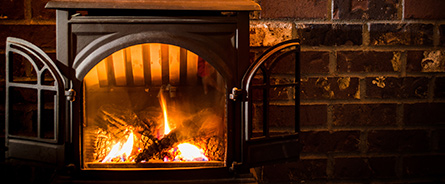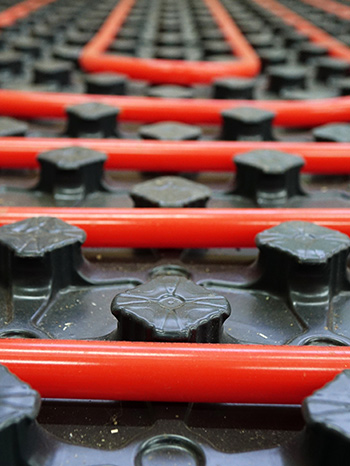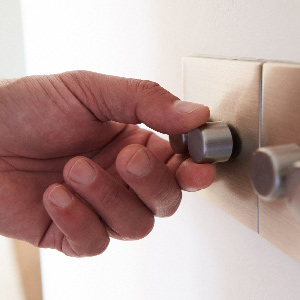The Ultimate
Underfloor Heating Guide
Post By: Ryan King On: 03-10-2018 - Smart Homes
Winter is coming, and so is the cold temperatures. With temperatures starting to turn many homeowners, maybe including yourself, are looking at ways to heat their home efficiently. Central heating and open fires are the two most common types of heating in UK homes.
However, underfloor heating has started to grow in popularity due to its lower costs and ease of install. This guide will go through the different types of underfloor heating, how to choose the right system, the advantages/disadvantages and many more questions you might have.

What is Underfloor Heating?
Underfloor heating comes in two primary forms, electric and water systems which heat up under the floor and the heat radiates upwards to heat a room. Underfloor heating can be used alongside other heating methods, or it can be used as the primary heat source, reducing the need for alternative heating solutions.
Electric underfloor heating solutions come in three forms. Cables, mats and foil. All these solutions work similarly by using electricity to heat up a wire under the floor which then heats up the room.
Water-based underfloor heating solutions work in a slightly different way. Water systems utilise a central heat source which heats up water and feeds it through a pump which pumps the water around your home to heat up your floors.

Water Vs Electric Underfloor Heating
Both water and electric underfloor heating solutions have their pros and cons, like with anything else you should take plenty of time to weigh up both systems to see which one will work with your property.
Water Systems
Pros
- Very efficient to run and works better in lower temperature environments.
- Works alongside a heat pump to increase efficiency.
Cons
- The initial setup of water-based systems can be much higher than electric-based systems.
- When using a water-based system, you will find that it costs similar to running radiators.
- Pipes under the floors and in walls can be harder to get to for repairs and maintenance.
Electric Systems
Pros
- Low setup costs. Typically electric systems are more affordable than any other heating source.
- The system does not require pipes to be run and does not require a central heating source. You only need access to your properties electrical system.
- Electric systems can easily be used on upper floors without the worry of a potential leak.
Cons
- Electric systems are more expensive than water-based systems to run.
- When placing furniture in a room that has a soft flooring like carpet, it is vital that care is taken to ensure that heavy furniture is not placed directly on top of the cables, potentially damaging them.
Which Underfloor Heating System Should I Use?
Choosing the right underfloor heating system is essential, as selecting the wrong system could cost you a lot of money and not be suited to the room you are using it in.
If you live in an area with cheap electricity or have access to renewable energy, electric underfloor heating solutions may be the best option for you. Electric systems are more affordable to install and are easier to maintain over time.
However, if you live in an area when electricity is expensive, you can look into water-based underfloor heating. Water systems have a much higher setup cost but over time will be more cost-effective than other heating sources and electric underfloor heating.
Electric underfloor heating is best suited for use under hard floor coverings like tiles, laminated wood and stone and water-based systems are perfect for use under most flooring types. When using a water-based system, you need to ensure that you are using the right insulation materials as the systems can increase and decrease in size slightly which can cause issues for some flooring types like ceramic tiles.
Electric underfloor heating solutions are perfect for small bathrooms or bedrooms while water underfloor heating is ideal for use in larger spaces and ground floors.
Advantages and Disadvantages of Using Underfloor Heating
Using underfloor heating has many advantages and disadvantages. Choosing the right system for your property comes down to your preference and the space that the system is going to be used in.
Advantages of Underfloor Heating
- Underfloor heating solutions evenly heat a room rather than the heat radiating from one or more sources.
- When using underfloor heating, you will not require radiators on the wall, resulting in a cleaner look.
- The systems can be lower to run than typical heating solutions.
- By heating the floor and not a wall mounted radiator you reduce the potential harm to children as heaters can get very hot.
- You can use underfloor heating with most floor coverings. It is worth noting that underfloor heating works best with tile, stone and wood floors as they retain heat while carpets do not maintain the temperature as well.
- Water systems can be used with a heat pump to reduce your home energy bills further.
Disadvantages of Underfloor Heating
- Water-based systems can leak, which means they are not suited to any floor but the ground floor.
- If you have a problem with a pipe under the floor or a mat is faulty you are required to remove your flooring, which in some cases cannot be relayed.
- Electric systems are more expensive to run in areas with higher energy costs.
- Cable mats and foils need to be protected from heavy loads and furniture to reduce the risk of damage to the system.
There are many advantages and disadvantages to owning an underfloor heating solution. However, careful planning and research is key to ensuring you pick the right system for your property.
Electric Underfloor Heating Accessories
Underfloor heating systems are regularly sold as kits which include most of the tools and materials required to install the system. There are many different accessories which you can choose from. Many manufacturers have a wide range of thermostats for their kits which range from simple dial thermostats all the way to smart, Internet-connected thermostats.
Many homeowners are starting to adopt smart thermostats which can connect to your home network to give you detailed information on your system, report problems and even be controlled by other smart home devices. You can read more about intelligent thermostats in our ultimate smart home guide.
For free cable solutions, there are a vast array of layout trays which can be attached to the floor and the cable is then run through the channels ensuring the cable is spread evenly across the floor and does not bend beyond its maximum bend limit.
During install it is vital you test the system for faults before any flooring is mounted on top. Many manufacturers sell a range of installation reporting and testing tools which can identify faults before you lay your flooring.

If you are looking to install an underfloor heating solution in your home contact our friendly team who can advise you on the right solution for your needs. We stock a variety of systems at competitive prices from the best manufacturers in the industry.
The Ultimate Underfloor Heating Guide
If you enjoyed this content you can download the PDF version to share.
Get More From Rowse Straight To Your Inbox



